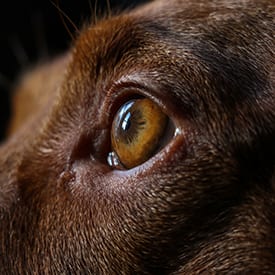If you’ve ever stopped to wonder whether or not your dog can see color, you’re not alone. Most pet owners wonder this at some point, and it’s a popular question among kids who have pet dogs as part of the family, too.
To better understand the relationship between dogs and the ability to see color, we first need to explore a little bit of the science behind color perception. Read through the article below to learn more about how color works, and from there, to find out more about just how much color your favorite canine companion can really see.
 How Color Works
How Color Works
There are nerves in your eyes that work to see color. These are called rods and cones. The cones in your eye tell the difference between colors, and the rods tell the difference between light and dark. Together, they combine to see not only color but also hue and saturation. A human can see colors on three different wavelengths including red, blue, and green. By using these three colors and their multiple combinations, you can see all perceptible colors to a human. A human who is colorblind, however, can only see two types of colors and their combinations instead.
Dogs don’t have as many cones in their eyes as humans do, so they can only see some of the colors we can see. However, they can see more than you might realize! Although dogs don’t have as many cones as humans, they have more rods, so they are able to tell the difference between light and dark more easily. This means they can see better in the dark and can also notice things moving from far away. The ability to see in these conditions makes them great at hunting, fetching, and retrieving, which are all important activities for a dog.
Is Everything Black-and-White to a Dog?
Definitely not! Although in the past it was believed that dogs could only see in black and white, we now know that they can see blues and yellows. This means that most shades of green and yellow all look about the same to dogs, while the same is true of shades of blue and purple. On the other hand, colors that fall into the red spectrum will look gray or brown to dogs and won’t stand out nearly as much as colors that have more yellow or blue in their hues.
So, just because a dog can only see blue and yellow colors, that also doesn’t mean she sees everything in the world in blue or yellow. Instead, it means that blue and yellow are the only true colors a dog can see, and most other colors will fall into those categories and appear blue or yellow when they’re actually purple or green. It’s fascinating to imagine the gray and brown reds of the world being interspersed by pops of blue and yellow color, but this is just what a dog sees every day, and it’s part of normal life for your pet.
But My Dog Has a Favorite Color Toy!
It can be hard to be told that your dog can’t really experience color the way you do, and to some dog owners, this is almost unbelievable. It’s difficult for kids and adults alike to wrap their minds around the concept of a dog seeing totally different colors than they see, but it’s true. And just because your dog seems to have a favorite color toy, that doesn’t necessarily mean she can see its color.
Since dogs can see blue and yellow, your dog’s favorite toy may be the blue one in a sea of reds. Or, on the other hand, if your dog has a bunch of yellow toys and just one red one, then the red might stand out to her more than the others because it appears different. In this way, she may seem to have a favorite color choice, but it just comes down to which color stands out the most at a given time. Her favorite toy probably has a lot more to do with its texture and smell, really!
In Conclusion
So what do you think? Do you feel like you’ve learned a lot about whether or not dogs can truly see color? With the help of the information in this article, you should be able to form a more solid understanding of what color is like from the point of view of a dog.
Science is always changing and exploring more about the animal world in-depth, so who knows? There’s a chance we might learn something new about dogs and how they perceive color in the future, too. But for now, this is what we know, and it’s useful to understand this when you have a dog as part of your household.
